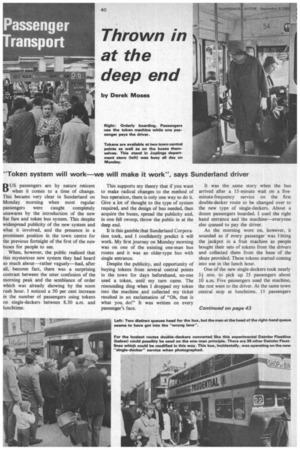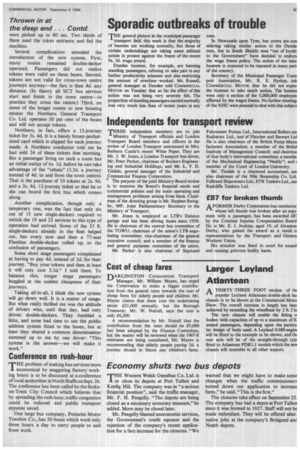Thrown in at the deep end
Page 42

Page 45

If you've noticed an error in this article please click here to report it so we can fix it.
by Derek Moses
"Token system will work—we will make it work", says Sunderland driver BUS passengers are by nature reticent when it comes to a time of change. This became very clear in Sunderland on Monday morning when most regular passengers were caught completely unawares by the introduction of the new flat fare and token bus system. This despite widespread publicity of the new system and what it involved, and the presence in a prominent position in the town centre for the previous fortnight of the first of the new buses for people to see.
When, however, the public realized that this mysterious new system they had heard so much about—rather vaguely—had, after all, become fact, there was a surprising contrast between the utter confusion of the morning peak and the semblance of order which was already showing by the noon rush hour. I noticed a 50 per cent increase in the number of passengers using tokens on single-deckers between 8.30 a.m. and lunchtime. This supports my theory that if you want to make radical changes to the method of bus operation, there is only one way to do it. Give a lot of thought to the type of system required, and the design of bus needed, then acquire the buses, spread the publicity and, in one fell swoop, throw the public in at the deep end.
It is this gamble that Sunderland Corporation took, and I confidently predict it will work. My first journey on Monday morning was on one of the existing one-man bus routes and it was an older-type bus with single entrance.
Despite the publicity, and opportunity of buying tokens from several central points in the town for days beforehand, no-one used a token, until my turn came. The resounding ding when I dropped my token into the machine and collected my ticket resulted in an exclamation of "Oh, that is what you do!" It was written on every passenger's face.
It was the same story when the bus arrived after a 15-minute wait on a fiveminute-frequency service on the first double-decker route to be changed over to the new type of single-deckers. About a dozen passengers boarded. I used the right hand entrance and -the machine—everyone else queued to pay the driver.
As the morning wore on, however, it sounded as if every passenger was f itting the jackpot in a fruit machine as people bought their sets of tokens from the drivers and collected them from the base of the shute provided. These tokens started coming into use in the lunch hour.
One of the new single-deckers took nearly 3-1min. to pick up 25 passengers about 10 a.m. Five passengers used the machine, the rest went to the driver. At the same town central stop at lunchtime, 15 passengers
the deep end . . . Contd.
were picked up in 80 sec. Two thirds of them used the token entrance and fed the machine.
Several complications attended the introduction of the new system. First, many routes remained double-decker operated. Passengers did not realize tokens were valid on these buses. Second, tokens are not valid for cross-town centre journeys anyway—the fare is then 4d. any distance. (In theory all SCT bus services start and finish in the town centre—in practice they cross the centre.) Third, on some of the longer routes to new housing estates the Northern General Transport Co. Ltd. operates 50 per cent of the buses and will not accept tokens.
Northern, in fact, offers a 12-journey ticket for 3s. 4d. It is a handy breast-pocketsized card which is clipped for each journey made. A Northern conductor told me he had sold 24 of these tickets that morning. But a passenger living on such a route has an initial outlay of 6s. Id. before he can take advantage of the "rebate" (3.3d. a journey instead of 4d. to and from the town centre). That is the purchase of 10 tokens at 2s. 9d. and a 3s. 4d. 12-journey ticket so that he or she can board the first bus which comes along.
Another complication, though only a temporary one, was the fact that only six out of 15 new single-deckers required to switch the 19 and 22 services to this type of operation had arrived. Sonic of the 33 ft. single-deckers already in the fleet helped out, but every now and then a 77-seat Fleetline double-decker rolled up, to the confusion of passengers.
Some short stage passengers complained at having to pay 4d. instead of 2d. for their journey. "Buy your tokens and then at least it will only cost 3.3d." I told them. To balance this, longer stage passengers boggled at the sudden cheapness of their journeys.
Taking all-in-all, I think the new system will go down well. It is a matter of usage. But what really thrilled me was the attitude of drivers who, until that day, had only driven double-deckers. They fumbled a little, and none had time to use the public address system fitted to the buses, but at least they shared a common determination summed up to me by one driver: "This system is the answer—we will make it work."
Conference on rush-hour
THE problem of making bus services more economical by staggering factory working hours is to be discussed at a conference of local authorities in North Staffs on Sept. 26. The conference has been called by the Stokeon-Trent City Council which believes that by spreading the rush hour, traffic congestion could be reduced and public transport expense saved.
One large bus company, Potteries Motor Traction Co., has 50 buses which work only three hours a day to carry people to and from work.
































































































































